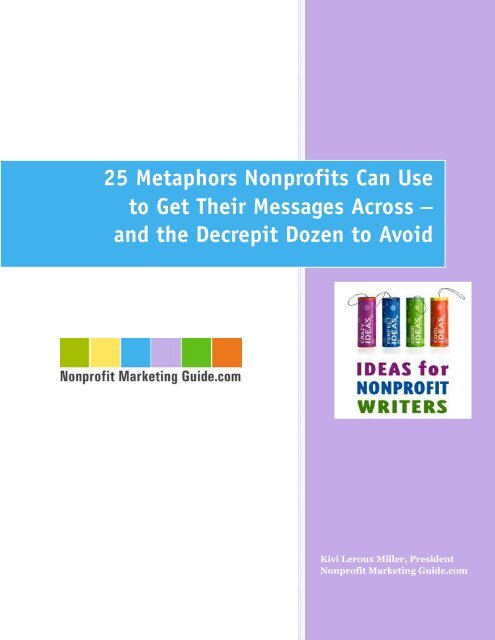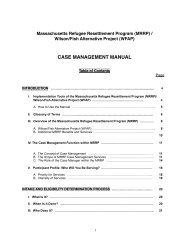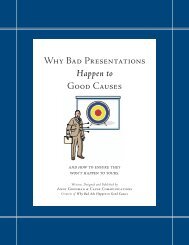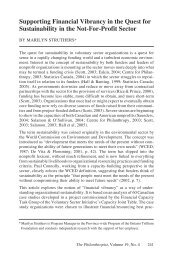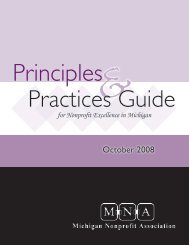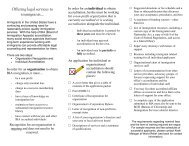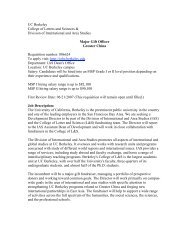You also want an ePaper? Increase the reach of your titles
YUMPU automatically turns print PDFs into web optimized ePapers that Google loves.
<strong>25</strong> <strong>Metaphors</strong> Nonprofits Can Use<br />
to Get Their Messages Across −<br />
and the Decrepit Dozen to Avoid<br />
Kivi Leroux Miller, President<br />
Nonprofit Marketing Guide.com
More Tips and Training for Do-It-Yourself Nonprofit Marketers<br />
Get your All-Access Pass to our Weekly Webinar Series<br />
for nonprofit communicators!<br />
• Attend as many of our live webinars as you want, or watch<br />
the recordings later<br />
• Includes the last three months of<br />
recordings too!<br />
• Invitations to special Pass Holder Only coaching calls with<br />
communications experts<br />
• Access to Kivi Leroux Miller’s office hours at reduced<br />
consulting rates<br />
Get your All-Access Pass for $145 for three months or<br />
save 20% with an annual pass for $465.<br />
Prices subject to change.<br />
“The Nonprofit Marketing Guide” in Paperback:<br />
Available from Your Favorite Online <strong>Book</strong>seller<br />
“Brilliant and comprehensive” ~ Mal Warwick<br />
“Required reading for every nonprofit.” ~ Nancy Schwartz<br />
“Everything you need in one book.” ~ Beth Kanter<br />
Buy from Amazon at kivilm.com/thebook<br />
Some examples in this e-book include screen captures for educational purposes.<br />
Images and text within the screen captures are property of the respective organizations.<br />
© 2010, Kivi Leroux Miller, NonprofitMarketingGuide.com<br />
NonprofitMarketingGuide.com | Nonprofit <strong>Metaphors</strong> 1
Why Nonprofits Need <strong>Metaphors</strong><br />
Much of the work that nonprofits do is either so familiar that it’s easily overlooked or so technical that it’s<br />
hard to understand. Nonprofit staff also frequently suffer from the “curse of knowledge” – because they<br />
know so much about their fields, they lose the ability to speak about that work in clear, simple terms.<br />
When we use metaphors, we say that some new idea or approach is like something else that we already<br />
understand. We help people see us from a fresh new perspective. Or we take a complicated or foreign idea<br />
and make it feel simple and familiar.<br />
Nonprofit communicators can use metaphors in several different ways.<br />
Clarifying Your Niche<br />
Lillian’s List of North Carolina, a political action committee that raises money for progressive women<br />
candidates, uses “Feel the Power of the Purse” as a tagline accompanied by an image of a fashionably<br />
dressed woman with a big purse. They also use actual purses like the ones in the photo at fundraising<br />
events. The imagery nicely ties together the ideas of today’s women, money, and<br />
political power.<br />
Using a metaphor as a tagline is another good way to clarify your niche.<br />
Because the earth needs a good lawyer. -- Earthjustice<br />
Nothing stops a bullet like a job. -- Homeboy Industries<br />
Open hearts. Open minds. Open doors. -- The United Methodist Church<br />
These three winners of the 2009 Nonprofit Tagline Awards all have one thing in<br />
common: They skillfully use metaphors to convey very quickly what the<br />
organization is all about.<br />
Making the Technical Feel More Touchy<br />
<strong>Metaphors</strong> can also turn what might normally be perceived as something cold,<br />
scientific, or technical into something that’s more touchy-feely, which can be very helpful when<br />
communicating with individual<br />
supporters.<br />
The Nature Conservancy refers to<br />
a coral restoration project at the<br />
Mote Marine Laboratory as “The<br />
Coral Nursery.” The word nursery<br />
conjures up images of babies that<br />
need tender care and attention,<br />
which is probably not how most<br />
people would describe rough coral<br />
on the bottom of the ocean. It’s a<br />
simple metaphor that instantly<br />
changes the way we think about<br />
coral.<br />
Source: Nature.org<br />
2 NonprofitMarketingGuide.com | Nonprofit <strong>Metaphors</strong><br />
Source: LilliansList.org
Overcoming Resistance<br />
If you suspect some reluctance on the part<br />
of potential supporters to follow through<br />
on your calls to action, metaphors can help<br />
you overcome that resistance. Aid<br />
organizations often have trouble raising<br />
funds for projects on foreign soil because<br />
they are “out of sight, out of mind” or<br />
donors don’t feel like the plight of people<br />
in other nations is their responsibility.<br />
Beyond Borders is overcoming that<br />
resistance with a series of animated images<br />
on its homepage, two of which are featured<br />
here. The images use travel metaphors of<br />
airplane flights and border crossings to<br />
help supporters understand why they<br />
should help Haiti.<br />
Bringing Data to Life<br />
Health and nutrition experts know that a diet of fresh foods – vegetables,<br />
fruit, meat and dairy products – can help prevent many diseases and<br />
obesity. Yet the residents of large sections of many major cities don’t live<br />
anywhere near a grocery store and are often forced to rely on processed<br />
foods from convenience<br />
stores and fast food for most<br />
meals.<br />
Cover of Red Eye Magazine with Feature<br />
Story on Chicago's Food Deserts<br />
Source: chicagonow.com<br />
Source: BeyondBorders.org<br />
But quoting statistics about<br />
the number of people who<br />
live a certain distance from a<br />
grocery store doesn’t convey<br />
the significance of the<br />
problem. Neither do maps<br />
alone.<br />
The metaphor food desert, on<br />
the other hand, does. The depth<br />
of the metaphor allows<br />
advocates to also talk about<br />
Chicago Neighborhoods<br />
Without Major Grocery<br />
Stores<br />
Source: Chicago Magazine<br />
thirst, starving, shifting sands, oasis, and more.<br />
NonprofitMarketingGuide.com | Nonprofit <strong>Metaphors</strong> 3
<strong>Metaphors</strong> can also be used as presentation themes, as provocative headlines and email subject lines, and<br />
more.<br />
Coming Up with the Right Metaphor for Your Organization<br />
Step 1: Relax!<br />
Thinking metaphorically is a creative process that’s hard to force. Give yourself some time and space to<br />
think.<br />
Step 2: Understand Your Goal<br />
What does the metaphor need to accomplish?<br />
Step 3: Review the List of <strong>Metaphors</strong> and See What Pops<br />
Look at the list of <strong>25</strong> metaphors and see if anything jumps out at you. If not, randomly select a category<br />
and start working through the questions in Step 4.<br />
Step 4: Explore Your Metaphor<br />
Take a few minutes to brainstorm as many elements of your metaphor as you can. Use these questions to<br />
help you think through the possibilities.<br />
• Who does this? Who else is involved?<br />
• What do people physically do?<br />
• What things or tools do they use?<br />
• What categories are used?<br />
• What decisions do they make?<br />
• What mistakes are common?<br />
• How do they learn?<br />
• What’s the timing?<br />
• What are the stages or steps in the process?<br />
• Where does it happen?<br />
• What defines success?<br />
• What defines disaster?<br />
• What are the special occasions or milestones?<br />
4 NonprofitMarketingGuide.com | Nonprofit <strong>Metaphors</strong><br />
When we use metaphors, we say<br />
that some new idea or approach is<br />
like something else that we<br />
already understand.<br />
What is your idea or approach like?
• What are the levels of mastery?<br />
• Who are the celebrities?<br />
• In what movies, books, or stories is this featured?<br />
With this long list of metaphorical elements in hand, think about how they are similar to the different<br />
aspects of the programs or services you are trying to explain (e.g., areas without grocery stores are like<br />
food deserts and growing coral on the ocean floor is like a coral nursery). Pick a handful of the best<br />
matches and start to build your explanation or story around them.<br />
Step 5: Decide Based on Your Audience’s Experiences<br />
As with any good communications, your audience is the ultimate decisionmaker on whether something<br />
works or not.<br />
How well will your audience relate to your metaphor given their professional and personal experiences?<br />
For example, a 60-year-old would draft a very different list of iconic movies and television programs than<br />
a <strong>25</strong>-year-old would. People who have never worked in a cubicle won’t understand office life metaphors in<br />
the same way as those who have.<br />
<strong>25</strong> <strong>Metaphors</strong> for Your Nonprofit<br />
Below are <strong>25</strong> metaphors that I think can work well in the nonprofit world. This is by no means a<br />
comprehensive list, but it’s long enough to get you thinking more creatively.<br />
The metaphors are grouped into two categories: Deep metaphors (based on the research explained in<br />
Marketing Metaphoria: What Deep <strong>Metaphors</strong> Reveal About the Minds of Consumers by Gerald Zaltman<br />
and Lindsay Zaltman) and surface metaphors. Deep metaphors are large, complex themes that work at<br />
the subconscious level. People often can’t articulate these feelings directly, even though they drive their<br />
decisionmaking. Surface metaphors are those found throughout everyday language and are therefore<br />
much more easily recognized and understood.<br />
When trying to come up with a metaphor for your work, it’s often helpful to pick one deep metaphor and<br />
then explore how several surface metaphors can work within the deep metaphor (e.g. exploring how<br />
surface metaphors like weather, exercise/fitness, or fashion can be used to elaborate on the deep<br />
metaphor of balance.)<br />
Next to each metaphor, you’ll find a handful of elements related to it to get you started. Remember to use<br />
the questions in Step #4 to fully explore the metaphor’s potential.<br />
Deep <strong>Metaphors</strong><br />
Balance. Equilibrium, justice, interplay.<br />
Transformation. Changes in substance, circumstance.<br />
Journey. Meeting of past, present, future.<br />
Container. Inclusion, exclusion, boundaries.<br />
NonprofitMarketingGuide.com | Nonprofit <strong>Metaphors</strong> 5
Connection. Relating to self and others.<br />
Resource. Acquisitions and their consequences.<br />
Control. Mastery, vulnerability, well-being.<br />
Surface <strong>Metaphors</strong><br />
Parenting. Growth spurts, stages, giving birth, pregnancy, nursery, family dinner, sibling rivalry, Brady<br />
Bunch, discipline, adoption, empty nest, sleepless nights, divorce, packing school lunches.<br />
Travel. Planes, trains, cars, delays, road trips, adventure, exploration, tickets, routes, missed flights,<br />
concierge, maps, mileage, speed, tourists, airport screening, motions sickness, souvenirs.<br />
Gardens, Forests, and Other Landscapes. Growth, blooms, weeds, mulch, annuals, perennials,<br />
insects, fertilizer, harvest, planting, plow, grasslands, ecosystems, mountain peaks, horizon.<br />
Sports. Teams, teaming up, scoring, winning, losing, competition, practice, game face, slam dunk, heavy<br />
hitting, goal, touchdown, three strikes, penalty, take aim, best shot, marathon, sore loser.<br />
Cooking, Food and Beverages. Recipes, cookbooks, ingredients, shopping list, bar tab, chefs,<br />
chopping block, culinary school, winemaking, baking, mixed drinks, burning, boiling, raw.<br />
Arts and Crafts. Cutting, pasting, scrapbooking, paint, color palettes, textures, galleries, shows, brushes,<br />
sketching, inspiration, patterns, decorating, stringing beads, finger painting, frames.<br />
Shopping. Sales, bargains, prices, mark-downs, close-outs, grocery lists, shopping carts, aisles, cash<br />
register, lines, secret shoppers, credit, returns, eBay, QVC, yard sales, convenience store, coupons.<br />
Banking and Economics. Savings, spending, budgets, balance sheets, investing, overdraft, insurance,<br />
refinance, equity, sell off, fees, loans, debit card, keep the change, wealth, deposit, withdrawal.<br />
Relationships and Romance. Love affairs, breakups, courtship, first dates, reunions, anniversaries,<br />
Valentine’s Day, dating, marriage counseling, living together, weddings, step-parents, just friends.<br />
Science and Technology. Formulas, white coats, DNA, computers, wireless, programming, research,<br />
experiments, injection, immunity, data, inventions, space, labs, results, findings, cells, Bill Nye.<br />
Games. Puzzles, chess board, video games, steps, solving, shell game, shuffle cards, house of cards,<br />
target, strategy, arcades, party games, players, family game night, bingo, prizes, Solitaire, patterns.<br />
Fashion. Styles, trends, trendsetter, tight fit, sales, fitting room, designers, collections, catwalk, models,<br />
Vogue, make-up, body image, out of style, chic, shape, cut, craze, back in style.<br />
Television and Movies. Soap operas, blockbusters, sequels, Oscars, supporting cast, three-act play,<br />
drama, clues, black-and-white, reception, 3-D, A Christmas Story, The Simpsons, the big screen.<br />
6 NonprofitMarketingGuide.com | Nonprofit <strong>Metaphors</strong>
Literature. Fairy tales, Disney stories, classics, Shakespeare, how the story unfolds, translation,<br />
mysteries, autobiography, writer’s retreat, hard cover, book stores, libraries, better than the movie.<br />
Weather. Clouds, lightening, taking cover, drought, forecasting, outlook, Katrina, soaking rains, sun<br />
shining through, storms, clear skies, temperature, floodgates, radar, TV weatherman, sunburn, frostbite.<br />
Superheroes. Special powers, villains, x-ray vision, comic books, flying, virtue, cape, costumes, idols,<br />
good v. evil, crime fighting, police dogs, firemen, save the day, dare devil, Captain __, Doctor __ .<br />
Faith and Spirituality. Revival, believe, pray, divine, worship, religion, values, soul, healing, practice,<br />
devotion, spirits, astrology, reincarnation, yoga, angels, Heaven, meditation, pagan, gods, shaman, sins.<br />
Fitness, Exercise, and Dieting. Weighing in, food diaries, treadmill, pedometers, calories, sweat,<br />
personal trainer, food pyramid, 100 calorie packs, body mass index, scales, heart rate, binging, nutrition.<br />
The Decrepit Dozen:<br />
12 Worn-out <strong>Metaphors</strong><br />
Nonprofits Should Avoid<br />
I’m declaring war on building<br />
bridges and helping hands!<br />
While the 12 metaphors listed here may<br />
still work at some level because they are<br />
very familiar, I believe they have been<br />
used so many times and in so many<br />
different ways in the nonprofit world that<br />
they are effectively meaningless. If you are<br />
using them, it's time to get more creative<br />
and search for phrases that are both clear<br />
and truly meaningful for your supporters<br />
today.<br />
EXAMPLE<br />
“Making Connections” <strong>Metaphors</strong>:<br />
Replacing “Building Bridges”<br />
with “Parenting and Family” <strong>Metaphors</strong><br />
• Family meeting<br />
• Family ties<br />
• Family dinners<br />
• Reconciling<br />
• Reunions<br />
• Dealing with sibling rivalries<br />
• Blending step-families<br />
• Looking into each other’s eyes<br />
Building Bridges. This is probably the<br />
most common metaphor used to explain how nonprofits make connections between people or ideas. But it<br />
tells us nothing about the benefits of those connections or why we really need to make them.<br />
Changing the World/Lives. Change isn't always for the better. Every one of us could argue that we<br />
change someone else's life every day.<br />
War on (Fill in the Blank). I don't think the military metaphors work all that well in the social service<br />
fields that most often use them. And with lagging public support for the real wars our nation is fighting, I<br />
don't think this metaphor conjures up the sense of common purpose and focus it once might have.<br />
NonprofitMarketingGuide.com | Nonprofit <strong>Metaphors</strong> 7
Making a Difference. If every nonprofit on the block can use the same phrase, that's a sure sign that it<br />
won't help you stand out in your marketing and fundraising. Every nonprofit is trying to make a<br />
difference. While the idea behind it is still relevant, this particular phrase isn't.<br />
Helping Hands. "Help" is just too generic. And much of the help that nonprofits provide isn't manual<br />
labor or physically in person, which "hands" implies.<br />
Cutting Edge. This refers to the newest,<br />
leading research or thinking – the state of<br />
the art – but it’s another worn-out cliché<br />
that says more about your lack of<br />
creativity than your approach to your<br />
work.<br />
While I think these first six are the worst,<br />
I’d also avoid these six too:<br />
• Strengthening Community<br />
• Creating Hope<br />
• Stand Up for . . .<br />
• Brighter Future<br />
• Turning Lives Around<br />
• The Voice of . . .<br />
Sources and Resources<br />
To learn more about how your nonprofit can use metaphors, check out these sources, many of which I<br />
used in my research for this e-book.<br />
Metaphorically Selling: How to Use the Magic of <strong>Metaphors</strong> to Sell, Persuade, and<br />
Explain Anything to Anyone by Anne Miller.<br />
Marketing Metaphoria: What Deep <strong>Metaphors</strong> Reveal About the Minds of Consumers by<br />
Gerald Zaltman and Lindsay Zaltman.<br />
The Metaphor Project, led by Susan Strong. www.metaphorproject.org<br />
delicious.com/ecoscribe/metaphors. Online articles I’ve saved.<br />
Search “visual metaphor” on YouTube. You’ll find many student projects and examples.<br />
Don’t Think of an Elephant: Know Your Values and Frame the Debate by George Lakoff, the<br />
language expert on the political left.<br />
Words That Work: It's Not What You Say, It's What People Hear by Frank Luntz, the language<br />
expert on the political right.<br />
8 NonprofitMarketingGuide.com | Nonprofit <strong>Metaphors</strong><br />
EXAMPLE<br />
“Giving Aid” <strong>Metaphors</strong>:<br />
Replacing “Helping Hands”<br />
with “Travel” <strong>Metaphors</strong><br />
• Concierge<br />
• Flight attendant<br />
• Buses stopping<br />
to pick people up<br />
• Making airplane<br />
connections<br />
• Tow truck<br />
• Air bags<br />
• Roadside<br />
assistance<br />
• Changing a flat tire<br />
• Paving a road<br />
• Coast Guard rescue<br />
helicopter


